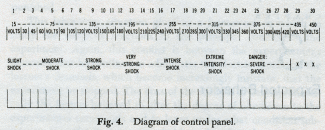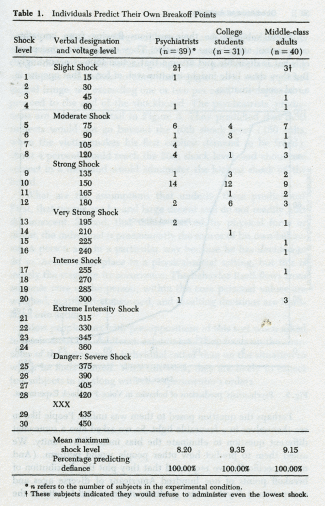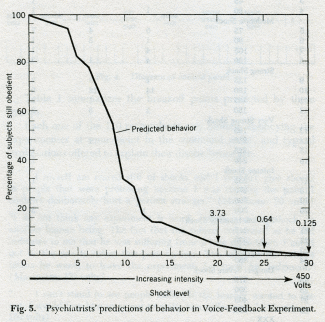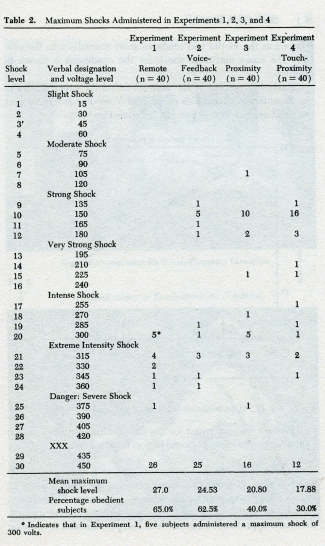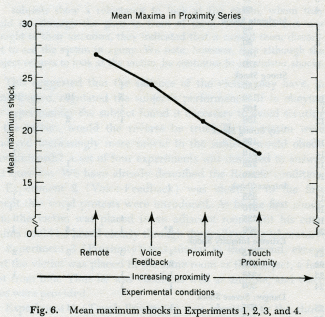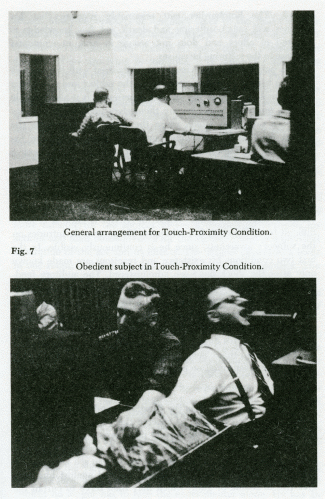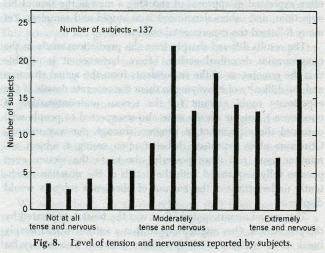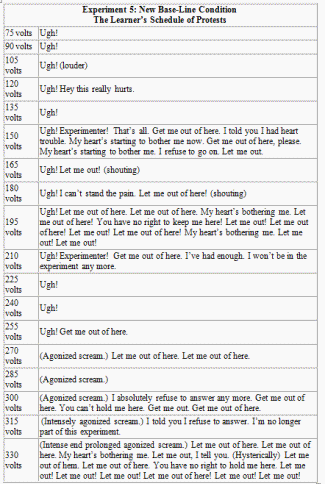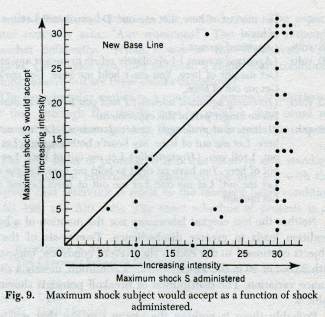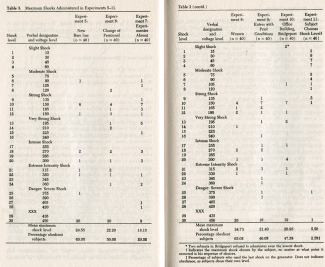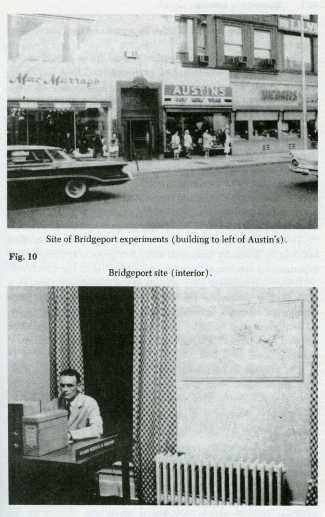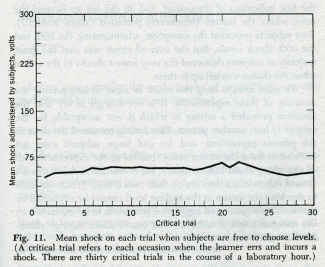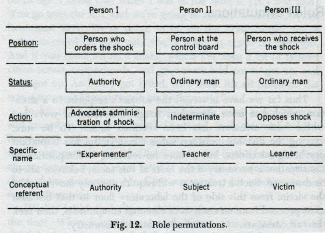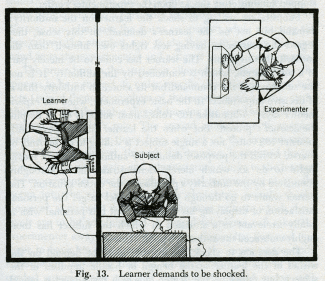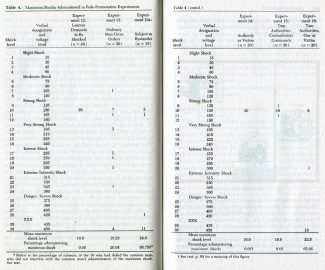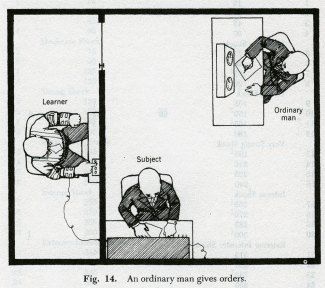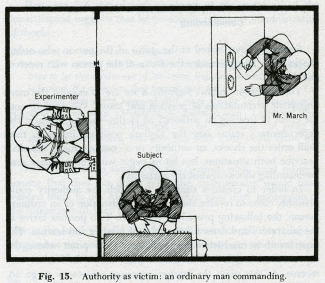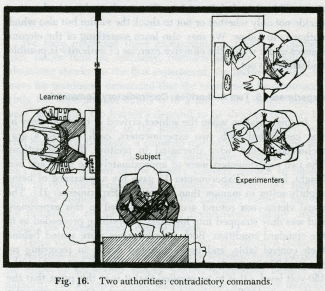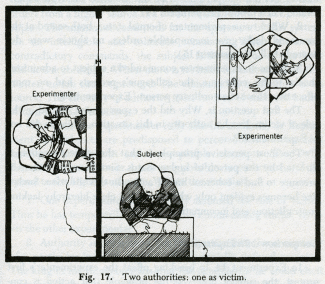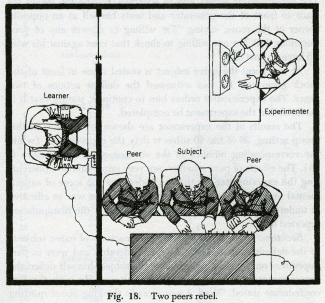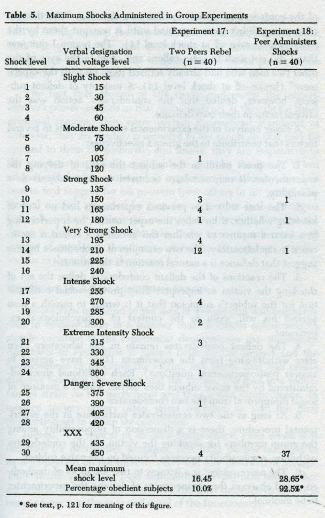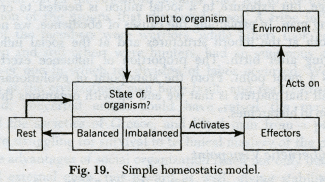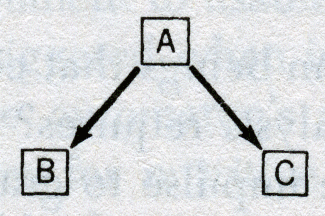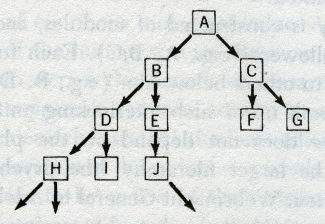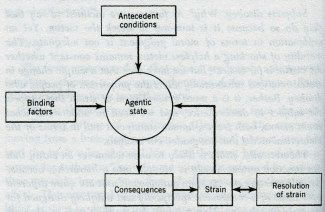11. The Process of Obedience: Applying the Analysis to the ExperimentNow that the agentic state is at the center of our analysis (diagrammed on next page), certain key questions arise. First, under what conditions will a person move from an autonomous to an agentic state? (antecedent conditions). Second, once the shift has occurred, what behavioral and psychological properties of the person are altered? (consequences). And, third, what keeps a person in the agentic state? (binding factors). Here a distinction is made between the conditions that produce entry into a state and those that maintain it. Let us now consider the process in detail.
Antecedent Conditions of ObedienceFirst, we need to consider forces that acted on the person before he became our subject, forces that shaped his basic orientation to the social world and laid the groundwork for obedience.
FamilyThe subject has grown up in the midst of structures of authority. From his very first years, he was exposed to parental regulation, whereby a sense of respect for adult authority was inculcated. Parental injunctions are also the source of moral imperatives. However, when a parent instructs a child to follow a moral injunction, he is, in fact, doing two things. First, he presents a specific ethical content to be followed. Second, he trains the child to comply with authoritative injunctions per se. Thus, when a parent says, “Don’t strike smaller children,” he provides not one imperative but two. The first concerns the manner in which the recipient of the command is to treat smaller children (the prototype of those who are helpless and innocent) the second and implicit imperative is, “And obey me!” Thus, the very genesis of our moral ideals is inseparable from the inculcation of an obedient attitude. Moreover, the demand for obedience remains the only consistent element across a variety of specific commands, and thus tends to acquire a prepotent strength relative to any particular moral content. [11]
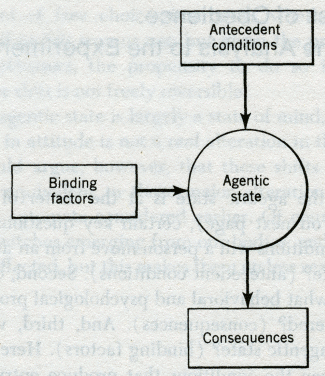
"There is one characteristic of the present direction of public opinion, peculiarly calculated to make it intolerant of any marked demonstration of individuality. The general average of mankind are not only moderate in intellect, but also moderate in inclinations: they have no tastes or wishes strong enough to incline them to do anything unusual, and they consequently do not understand those who have, and class all such with the wild and intemperate whom they are accustomed to look down upon. Now, in addition to this fact which is general, we have only to suppose that a strong movement has set in towards the improvement of morals, and it is evident what we have to expect. In these days such a movement has set in; much has actually been effected in the way of increased regularity of conduct, and discouragement of excesses; and there is a philanthropic spirit abroad, for the exercise of which there is no more inviting field than the moral and prudential improvement of our fellow-creatures. These tendencies of the times cause the public to be more disposed than at most former periods to prescribe general rules of conduct, and endeavor to make every one conform to the approved standard. And that standard, express or tacit, is to desire nothing strongly. Its ideal of character is to be without any marked character; to maim by compression, like a Chinese lady's foot, every part of human nature which stands out prominently, and tends to make the person markedly dissimilar in outline to commonplace humanity.
As is usually the case with ideals which exclude one half of what is desirable, the present standard of approbation produces only an inferior imitation of the other half. Instead of great energies guided by vigorous reason, and strong feelings strongly controlled by a conscientious will, its result is weak feelings and weak energies, which therefore can be kept in outward conformity to rule without any strength either of will or of reason. Already energetic characters on any large scale are becoming merely traditional. There is now scarcely any outlet for energy in this country except business. The energy expended in that may still be regarded as considerable. What little is left from that employment, is expended on some hobby; which may be a useful, even a philanthropic hobby, but is always some one thing, and generally a thing of small dimensions. The greatness of England is now all collective: individually small, we only appear capable of anything great by our habit of combining; and with this our moral and religious philanthropists are perfectly contented. But it was men of another stamp than this that made England what it has been; and men of another stamp will be needed to prevent its decline."
-- John Stuart Mill, "On Liberty"
Institutional SettingAs soon as the child emerges from the cocoon of the family, he is transferred to an institutional system of authority, the school. Here, the child learns not merely a specific curriculum but also how to function within an organizational framework. His actions are, to a significant degree, regulated by his teachers, but he can perceive that they in turn are subjected to the discipline and requirements of a headmaster. The student observes that arrogance is not passively accepted by authority but severely rebuked and that deference is the only appropriate and comfortable response to authority.
The first twenty years of the young person’s life are spent functioning as a subordinate element in an authority system, and upon leaving school, the male usually moves into either a civilian job or military service. On the job, he learns that although some discreetly expressed dissent is allowable, an underlying posture of submission is required for harmonious functioning with superiors. However much freedom of detail is allowed the individual, the situation is defined as one in which he is to do a job prescribed by someone else.
While structures of authority are of necessity present in all societies, advanced or primitive, modern society has the added characteristic of teaching individuals to respond to impersonal authorities. Whereas submission to authority is probably no less for an Ashanti than for an American factory worker, the range of persons who constitute authorities for the native are all personally known to him, while the modern industrial world forces individuals to submit to impersonal authorities, so that responses are made to abstract rank, indicated by an insignia, uniform or title.
RewardsThroughout this experience with authority, there is continual confrontation with a reward structure in which compliance with authority has been generally rewarded, while failure to comply has most frequently been punished. Although many forms of reward are meted out for dutiful compliance, the most ingenious is this: the individual is moved up a niche in the hierarchy, thus both motivating the person and perpetuating the structure simultaneously. This form of reward, “the promotion,” carries with it profound emotional gratification for the individual but its special feature is the fact that it ensures the continuity of the hierarchical form.
The net result of this experience is the internalization of the social order -- that is, internalizing the set of axioms by which social life is conducted. And the chief axiom is: do what the man in charge says. Just as we internalize grammatical rules, and can thus both understand and produce new sentences, so we internalize axiomatic rules of social life which enable us to full social requirements in novel situations. In any hierarchy of rules, that which requires compliance to authority assumes a paramount position.
Among the antecedent conditions, therefore, are the individual’s familial experience, the general societal setting built on impersonal systems of authority, and extended experience with a reward structure in which compliance with authority is rewarded, and failure to comply punished. While without doubt providing the background against which our subject’s habits of conduct were formed, these conditions are beyond the control of experimentation and do not immediately trigger movement to the agentic state. Let us now turn to the more immediate factors, within a specific situation, that lead to the agentic state.
Immediate Antecedent ConditionsPerception of authority. The first condition needed for transformation to the agentic state is the perception of a legitimate authority. From a psychological standpoint, authority means the person who is perceived to be in a position of social control within a given situation. Authority is contextually perceived and does not necessarily transcend the situation in which it is encountered. For example, should the experimenter encounter the subject on the street, he would have no special influence on him. A pilot’s authority over his passengers does not extend beyond the airplane. Authority is normatively supported: there is a shared expectation among people that certain situations do ordinarily have a socially controlling figure. Authority need not possess high status in the sense of “prestige.” For example, an usher at a theater is a source of social control to whom we ordinarily submit willingly. The power of an authority stems not from personal characteristics but from his perceived position in a social structure.
The question of how authority communicates itself seems, at first, not to require a special answer. We invariably seem to know who is in charge. We may, nonetheless, examine the behavior in the laboratory to try to dissect the process a little.
First, the subject enters the situation with the expectation that someone will be in charge. Thus, the experimenter, upon first presenting himself, fills a gap experienced by the subject. Accordingly, the experimenter need not assert his authority, but merely identify it. He does so through a few introductory remarks, and since this self-defining ritual fits perfectly with the subject’s expectation of encountering a man in charge, it is not challenged. A supporting factor is the confidence and “air of authority” exhibited by the experimenter. Just as a servant possesses a deferential manner, so his master exudes a commanding presence that subtly communicates his dominant status within the situation at hand.
Second, external accouterments are often used to signify the authority in a given situation. Our experimenter was dressed in a gray technician’s coat, which linked him to the laboratory. Police, military, and other service uniforms are the most conspicuous signs of authority within common experience. Third, the subject notes the absence of competing authorities. (No one else claims to be in charge, and this helps confirm the presumption that the experimenter is the right man.) Fourth, there is the absence of conspicuously anomalous factors (e.g., a child of five claiming to be the scientist).
It is the appearance of authority and not actual authority to which the subject responds. Unless contradictory information or anomalous facts appear, the self-designation of the authority almost always suffices. [12]
Entry into the Authority System. A second condition triggering the shift to the agentic state is the act of defining the person as part of the authority system in question. It is not enough that we perceive an authority, he must be an authority relevant to us. Thus, if we watch a parade, and hear a Colonel shout, “Left face,” we do not turn left, for we have not been defined as subordinate to his command. There is always a transition from that moment when we stand outside an authority system to that point when we are inside it. Authority systems are frequently limited by a physical context, and often we come under the influence of an authority when we cross the physical threshold into his domain. The fact that this experiment is carried out in a laboratory has a good deal to do with the degree of obedience exacted. There is a feeling that the experimenter “owns” the space and that the subject must conduct himself fittingly, as if a guest in someone’s house. If the experiment were to be carried on outside the laboratory, obedience would drop sharply. [13]
Even more important, for the present experiment, is the fact that entry into the experimenter’s realm of authority is voluntary, undertaken through the free will of the participants. The psychological consequence of voluntary entry is that it creates a sense of commitment and obligation which will subsequently play a part in binding the subject to his role.
Were our subjects forcibly introduced to the experiment, they might well yield to authority, but the psychological mechanisms would be quite different from what we have observed. Generally, and wherever possible, society tries to create a sense of voluntary entry into its various institutions. Upon induction into the military, recruits take an oath of allegiance, and volunteers are preferred to inductees. While people will comply with a source of social control under coercion (as when a gun is aimed at them), the nature of obedience under such circumstances is limited to direct surveillance. When the gumnan leaves, or when his capacity for sanctions is eliminated, obedience stops. In the case of voluntary obedience to a legitimate authority, the principal sanctions for disobedience come from within the person. They are not dependent upon coercion, but stem from the individual’s sense of commitment to his role. In this sense, there is an internalized basis for his obedience, not merely an external one.
Coordination of Command with the Function of Authority. Authority is the perceived source of social control within a specific context. The context defines the range of commands considered appropriate to the authority in question. There must, in general, be some intelligible link between the function of the controlling person, and the nature of the commands he issues. The connection need not be very well worked out but need only make sense in the most general way. Thus, in a military situation, a captain may order a subordinate to perform a highly dangerous action, but he may not order the subordinate to embrace his girlfriend. In one case, the order is logically linked to the general function of the military, and in the other case it is not. [14]
In the obedience experiment, the subject acts within the context of a learning experiment and sees the experimenter’s commands as meaningfully coordinated to his role. In the context of the laboratory, such commands are felt to be appropriate in a general way, however much one may argue with certain specific developments that later occur.
Because the experimenter issues orders in a context he is presumed to know something about, his power is increased. Generally, authorities are felt to know more than the person they are commanding; whether they do or not, the occasion is defined as if they do. Even when a subordinate possesses a greater degree of technical knowledge than his superior, he must not presume to override the authority's right to command but must present this knowledge to the superior to dispose of as he wishes. A typical source of strain occurs in authority systems when the person in authority is incompetent to the point of endangering the subordinates. [15]
The Overarching Ideology. The perception of a legitimate source of social control within a defined social occasion is a necessary prerequisite for a shift to the agentic state. But the legitimacy of the occasion itself depends on its articulation to a justifying ideology. When subjects enter the laboratory and are told to perform, they do not in a bewildered fashion cry out, "I never heard of science. What do you mean by this?" Within this situation, the idea of science and its acceptance as a legitimate social enterprise provide the overarching ideological justification for the experiment. Such institutions as business, the church, the government, and the educational establishment provide other legitimate realms of activity, each justified by the values and needs of society, and also, from the standpoint of the typical person, accepted because they exist as part of the world in which he is born and grows up. Obedience could be secured outside such institutions, but it would not be the form of willing obedience, in which the person complies with a strong sense of doing the right thing. Moreover, if the experiment were carried out in a culture very different from our own -- say, among Trobrianders -- it would be necessary to find the functional equivalent of science in order to obtain psychologically comparable results. The Trobriander may not believe in scientists, but he respects witch doctors. The inquisitor of sixteenth-century Spain might have eschewed science, but he embraced the ideology of his church, and in its name, and for its preservation, tightened the screw on the rack without any problem of conscience.
Ideological justification is vital in obtaining willing obedience, for it permits the person to see his behavior as serving a desirable end. Only when viewed in this light, is compliance easily exacted.
An authority system, then, consists of a minimum of two persons sharing the expectation that one of them has the right to prescribe behavior for the other. In the current study, the experimenter is the key element in a system that extends beyond his person. The system includes the setting of the experiment, the impressive laboratory equipment, the devices which inculcate a sense of obligation in the subject, the mystique of science of which the experiment is a part, and the broad institutional accords that permit such activities to go on -- that is, the diffuse societal support that is implied by the very fact that the experiment is being run and tolerated in a civilized city.
The experimenter acquires his capacity to influence behavior not by virtue of the exercise of force or threat but by virtue of the position he occupies in a social structure. There is general agreement not only that he can influence behavior but that he ought to be able to. Thus, his power comes about in some degree through the consent of those over whom he presides. But once this consent is initially granted, its withdrawal does not proceed automatically or without great cost.
The Agentic StateWhat are the properties of the agentic state, and its consequences for the subject?
Moved into the agentic state, the person becomes something different from his former self, with new properties not easily traced to his usual personality.
First, the entire set of activities carried out by the subject comes to be pervaded by his relationship to the experimenter; the subject typically wishes to perform competently and to make a good appearance before this central figure. He directs his attention to those features of the situation required for such competent performance. He attends to the instructions, concentrates on the technical requirements of administering shocks, and finds himself absorbed in the narrow technical tasks at hand. Punishment of the learner shrinks to an insignificant part of the total experience, a mere gloss on the complex activities of the laboratory.
TuningThose not familiar with the experiment may think that the predicament of the subject is one in which he is assaulted by conflicting forces emanating from the learner and the experimenter. In a very real sense, however, a process of tuning occurs in the subject, with maximal receptivity to the emissions of the authority, whereas the learner’s signals are muted and psychologically remote. Those who are skeptical of this effect might observe the behavior of individuals organized in a hierarchical structure. The meeting of a company president with his subordinates will do. The subordinates respond with attentive concern to each word uttered by the president. Ideas originally mentioned by persons of a low status will frequently not be heard, but when repeated by the president, they are greeted with enthusiasm.
There is nothing especially malicious in this; it reflects the natural responses to authority. If we explore a little more deeply, we will see why this is so: the person in authority, by virtue of that position, is in the optimal position to bestow benefits or inflict deprivations. The boss can fire or promote; the military superior can send a man into dangerous combat or give him a soft job; the tribal patriarch consents to a marriage or orders an execution; thus, it is highly adaptive to attend with meticulous concern to authority’s whim.
Because of this, authority tends to be seen as something larger than the individual. The individual often views authority as an impersonal force, whose dictates transcend mere human wish or desire. Those in authority acquire, for some, a suprahuman character.
The phenomenon of differential tuning occurs with impressive regularity in the experiment at hand. The learner operates under the handicap that the subject is not truly attuned to him, for the subject’s feelings and percepts are dominated by the presence of the experimenter. For many subjects, the learner becomes simply an unpleasant obstacle interfering with attainment of a satisfying relationship with the experimenter. His pleas for mercy are consequential only in that they add a certain discomfort to what evidently is required of the subject if he is to gain the approval of the central emotional figure in the situation.
Redefining the Meaning of the SituationControl the manner in which a man interprets his world, and you have gone a long way toward controlling his behavior. That is why ideology, an attempt to interpret the condition of man, is always a prominent feature of revolutions, wars, and other circumstances in which individuals are called upon to perform extraordinary action. Governments invest heavily in propaganda, which constitutes the official manner of interpreting events.
Every situation also possesses a kind of ideology, which we call the “definition of the situation,” and which is the interpretation of the meaning of a social occasion. It provides the perspective through which the elements of a situation gain coherence. An act viewed in one perspective may seem heinous; the same action viewed in another perspective seems fully warranted. There is a propensity for people to accept definitions of action provided by legitimate authority. That is, although the subject performs the action, he allows authority to define its meaning.
It is this ideological abrogation to the authority that constitutes the principal cognitive basis of obedience. If, after all, the world or the situation is as the authority defines it, a certain set of actions follows logically.
The relationship between authority and subject, therefore, cannot be viewed as one in which a coercive figure forces action from an unwilling subordinate. Because the subject accepts authority’s definition of the situation, action follows willingly.
Loss of ResponsibilityThe most far-reaching consequence of the agentic shift is that a man feels responsible to the authority directing him but feels no responsibility for the content of the actions that the authority prescribes. Morality does not disappear, but acquires a radically different focus: the subordinate person feels shame or pride depending on how adequately he has performed the actions called for by authority.
Language provides numerous terms to pinpoint this type of morality: loyalty, duty, discipline, all are terms heavily saturated with moral meaning and refer to the degree to which a person fulfills his obligations to authority. They refer not to the “goodness” of the person per se but to the adequacy with which a subordinate fulfills his socially defined role. The most frequent defense of the individual who has performed a heinous act under command of authority is that he has simply done his duty. In asserting this defense, the individual is not introducing an alibi concocted for the moment but is reporting honestly on the psychological attitude induced by submission to authority.
"In our times, from the highest class of society down to the lowest every one lives as under the eye of a hostile and dreaded censorship. Not only in what concerns others, but in what concerns only themselves, the individual, or the family, do not ask themselves -- what do I prefer? or, what would suit my character and disposition? or, what would allow the best and highest in me to have fair play, and enable it to grow and thrive? They ask themselves, what is suitable to my position? what is usually done by persons of my station and pecuniary circumstances? or (worse still) what is usually done by persons of a station and circumstances superior to mine? I do not mean that they choose what is customary, in preference to what suits their own inclination. It does not occur to them to have any inclination, except for what is customary. Thus the mind itself is bowed to the yoke: even in what people do for pleasure, conformity is the first thing thought of; they like in crowds; they exercise choice only among things commonly done: peculiarity of taste, eccentricity of conduct, are shunned equally with crimes: until by dint of not following their own nature, they have no nature to follow: their human capacities are withered and starved: they become incapable of any strong wishes or native pleasures, and are generally without either opinions or feelings of home growth, or properly their own. Now is this, or is it not, the desirable condition of human nature?
It is so, on the Calvinistic theory. According to that, the one great offence of man is Self-will. All the good of which humanity is capable, is comprised in Obedience. You have no choice; thus you must do, and no otherwise; "whatever is not a duty is a sin." Human nature being radically corrupt, there is no redemption for any one until human nature is killed within him. To one holding this theory of life, crushing out any of the human faculties, capacities, and susceptibilities, is no evil: man needs no capacity, but that of surrendering himself to the will of God: and if he uses any of his faculties for any other purpose but to do that supposed will more effectually, he is better without them. That is the theory of Calvinism; and it is held, in a mitigated form, by many who do not consider themselves Calvinists; the mitigation consisting in giving a less ascetic interpretation to the alleged will of God; asserting it to be his will that mankind should gratify some of their inclinations; of course not in the manner they themselves prefer, but in the way of obedience, that is, in a way prescribed to them by authority; and, therefore, by the necessary conditions of the case, the same for all.
It is not by wearing down into uniformity all that is individual in themselves, but by cultivating it and calling it forth, within the limits imposed by the rights and interests of others, that human beings become a noble and beautiful object of contemplation; and as the works partake the character of those who do them, by the same process human life also becomes rich, diversified, and animating, furnishing more abundant aliment to high thoughts and elevating feelings, and strengthening the tie which binds every individual to the race, by making the race infinitely better worth belonging to. In proportion to the development of his individuality, each person becomes more valuable to himself, and is therefore capable of being more valuable to others. There is a greater fullness of life about his own existence, and when there is more life in the units there is more in the mass which is composed of them. As much compression as is necessary to prevent the stronger specimens of human nature from encroaching on the rights of others, cannot be dispensed with; but for this there is ample compensation even in the point of view of human development. The means of development which the individual loses by being prevented from gratifying his inclinations to the injury of others, are chiefly obtained at the expense of the development of other people. And even to himself there is a full equivalent in the better development of the social part of his nature, rendered possible by the restraint put upon the selfish part. To be held to rigid rules of justice for the sake of others, develops the feelings and capacities which have the good of others for their object. But to be restrained in things not affecting their good, by their mere displeasure, develops nothing valuable, except such force of character as may unfold itself in resisting the restraint. If acquiesced in, it dulls and blunts the whole nature. To give any fair play to the nature of each, it is essential that different persons should be allowed to lead different lives. In proportion as this latitude has been exercised in any age, has that age been noteworthy to posterity. Even despotism does not produce its worst effects, so long as Individuality exists under it; and whatever crushes individuality is despotism, by whatever name it may be called, and whether it professes to be enforcing the will of God or the injunctions of men."
-- John Stuart Mill, "On Liberty"
For a man to feel responsible for his actions, he must sense that the behavior has flowed from “the self.” In the situation we have studied, subjects have precisely the opposite view of their actions -- namely, they see them as originating in the motives of some other person. Subjects in the experiment frequently said, “If it were up to me, I would not have administered shocks to the learner.”
Superego functions shift from an evaluation of the goodness or badness of the acts to an assessment of how well or poorly one is functioning in the authority system. [16] Because the inhibitory forces which prevent the individual from acting harshly against others on his own are short-circuited, actions are no longer limited by conscience.
Consider an individual who, in everyday life, is gentle and kind. Even in moments of anger he does not strike out against those who have frustrated him. Feeling that he must spank a mischievous child, he finds the task distasteful; indeed, the very musculature in his arms becomes paralyzed, and he abandons the task. Yet, when taken into military service he is ordered to drop bombs on people, and he does so. The act does not originate in his own motive system and thus is not checked by the inhibitory forces of his internal psychological system. In growing up, the normal individual has learned to check the expression of aggressive impulses. But the culture has failed, almost entirely, in inculcating internal controls on actions that have their origin in authority. For this reason, the latter constitutes a far greater danger to human survival. [17]
Self-imageIt is not only important to people that they look good to others, they must also look good to themselves. A person’s ego ideal can be an important source of internal inhibitory regulation. Tempted to perform harsh action, he may assess its consequences for his self-image and refrain. But once the person has moved into the agentic state, this evaluative mechanism is wholly absent. The action, since it no longer stems from motives of his own and longer reflects on his self-image and thus has no consequences for self-conception. Indeed, the individual frequently discerns an opposition between what he himself wishes on the one hand and what is required of him on the other. He sees the action, even though he performs it, as alien to his nature. For this reason, actions performed under command are, from the subject’s viewpoint, virtually guiltless, however inhumane they may be. And it is toward authority that the subject turns for confirmation of his worth.
Commands and the Agentic StateThe agentic state constitutes a potential out of which specific acts of obedience flow. But something more than the potential is required -- namely, specific commands that serve as the triggering mechanism. We have already pointed out that, in a general way, the commands given must be consistent with the role of authority. A command consists of two main parts: a definition of action and the imperative that the action be executed. (A request, for example, contains a definition of action but lacks the insistence that it be carried out.)
Commands, then, lead to specific acts of obedience. Is the agentic state just another word for obedience? No, it is that state of mental organization which enhances the likelihood of obedience. Obedience is the behavioral aspect of the state. A person may be in an agentic state -- that is, in a state of openness to regulation from an authority -- without ever being given a command and thus never having to obey.
Binding FactorsOnce a person has entered the agentic state, what keeps him in it? Whenever elements are linked in a hierarchy, there need to be forces to maintain them in that relationship. If these did not exist, the mildest perturbation would bring about the disintegration of the structure. Therefore, once people are brought into a social hierarchy, there must be some cementing mechanism to endow the structure with at least minimal stability.
Some people interpret the experimental situation as one in which the subject, in a highly rational manner can weigh the conflicting values in the situation, process the factors according to some mental calculus, and base his actions on the outcome of this equation. Thus, the subject’s predicament is reduced to a problem of rational decision making. This analysis ignores a crucial aspect of behavior illuminated by the experiments. Though many subjects make the intellectual decision that they should not give any more shocks to the learner, they are frequently unable to transform this conviction into action. Viewing these subjects in the laboratory, one can sense their intense inner struggle to extricate themselves from the authority, while ill-defined but powerful bonds hold them at the shock generator. One subject tells the experimenter: “He can’t stand it. I’m not going to kill that man in there. You hear him hollering in there. He’s hollering. He can’t stand it.” Although at the verbal level the subject has resolved not to go on, he continues to act in accord with the experimenter’s commands. Many subjects make tentative movements toward disobedience but then seem restrained, as if by a bond. Let us now examine the forces that powerfully bind a subject to his role.
The best way to begin tracing these forces is to ask: What does the subject have to go through if he wants to break off? Through what psychological underbrush must he cut to get from his position in front of the shock generator to a stance of defiance?
Sequential Nature of the Action The laboratory hour is an unfolding process in which each action influences the next. The obedient act is preservative; after the initial instructions, the experimenter does not command the subject to initiate a new act but simply to continue doing what he is doing. The recurrent nature of the action demanded of the subject itself creates binding forces. As the subject delivers more and more painful shocks, he must seek to justify to himself what he has done; one form of justification is to go to the end. For if he breaks off, he must say to himself: “Everything I have done to this point is bad, and I now acknowledge it by breaking off.” But, if he goes on, he is reassured about his past performance. Earlier actions give rise to discomforts, which are neutralized by later ones. [18] And the subject is implicated into the destructive behavior in piecemeal fashion.
Situational ObligationsUnderlying all social occasions is a situational etiquette that plays a part in regulating behavior. In order to break off the experiment, the subject must breach the implicit set of understandings that are part of the social occasion. He made an initial promise to aid the experimenter, and now he must renege on this commitment. Although to the outsider the act of refusing to shock stems from moral considerations, the action is experienced by the subject as renouncing an obligation to the experimenter, and such repudiation is not undertaken lightly. There is another side to this matter.
Goffman (1959) points out that every social situation is built upon a working consensus among the participants. One of its chief premises is that once a definition of the situation has been projected and agreed upon by participants, there shall be no challenge to it. Indeed, disruption of the accepted definition by one participant has the character of moral transgression. Under no circumstance is open conflict about the definition of the situation compatible with polite social exchange.
More specifically, according to Goffman’s analysis, “society is organized on the principle that any individual who possesses certain social characteristics has a moral right to expect that others will value and treat him in a correspondingly appropriate way. When an individual projects a definition of the situation and then makes an implicit or explicit claim to be a person of a particular kind, he automatically exerts a moral demand upon the others, obliging them to value and treat him in the manner that persons of his kind have a right to expect” (page 185). Since to refuse to obey the experimenter is to reject his claim to competence and authority in this situation, a severe social impropriety is necessarily involved.
The experimental situation is so constructed that there is no way the subject can stop shocking the learner without violating the experimenter’s self-definition. The teacher cannot break off and at the same time protect the authority’s definitions of his own competence. Thus, the subject fears that if he breaks off, he will appear arrogant, untoward, and rude. Such emotions, although they appear small in scope alongside the violence being done to the learner, nonetheless help bind the subject into obedience. They suffuse the mind and feelings of the subject, who is miserable at the prospect of having to repudiate the authority to his face. The entire prospect of turning against the experimental authority, with its attendant disruption of a well-defined social situation, is an embarrassment that many people are unable to face up to. [19] In an effort to avoid this awkward event, many subjects find obedience a less painful alternative.
In ordinary social encounters precautions are frequently taken to prevent just such disruption of the occasion, but the subject finds himself in a situation where even the discreet exercise of tact cannot save the experimenter from being discredited. Only obedience can preserve the experimenter’s status and dignity. It is a curious thing that a measure of compassion on the part of the subject, an unwillingness to “hurt” the experimenter’s feelings, are part of those binding forces inhibiting disobedience. The withdrawal of such deference may be as painful to the subject as to the authority he defies. Readers who feel this to be a trivial consideration ought to carry out the following experiment. It will help them feel the force of inhibition that operates on the subject.
First, identify a person for whom you have genuine respect, preferably someone older than yourself by at least a generation, and who represents an authority in an important life domain. He could be a respected professor, a beloved priest, or under certain circumstances a parent. It must also be a person whom you refer to with some title such as Professor Parsons, Father Paul, or Dr. Charles Brown. He must be a person who represents to you the distance and solemnity of a genuine authority. To understand what it means to breach the etiquette of relations with authority, you need merely present yourself to the person and, in place of using his title, whether it be Dr., Professor, or Father, address him using his first name, or perhaps even an appropriate nickname. You may state to Dr. Brown, for example, “Good morning, Charlie!”
As you approach him you will experience anxiety and a powerful inhibition that may well prevent successful completion of the experiment. You may say to yourself: “Why should I carry out this foolish experiment? I have always had a fine relationship with Dr. Brown, which may now be jeopardized. Why should I appear arrogant to him?”
More than likely, you will not be able to perform the disrespectful action, but even in attempting it you will gain a greater understanding of the feelings experienced by our subjects.
Social occasions, the very elements out of which society is built, are held together, therefore, by the operation of a certain situational etiquette, whereby each person respects the definition of the situation presented by another and in this way avoids conflict, embarrassment, and awkward disruption of social exchange. The most basic aspect of that etiquette does not concern the content of what transpires from one person to the next but rather the maintenance of the structural relations between them. Such relations can be those of equality or of hierarchy. When the occasion is defined as one of hierarchy, any attempt to alter the defined structure will be experienced as a moral transgression and will evoke anxiety, shame, embarrassment, and diminished feelings of self-worth. [20] [21]
AnxietyThe fears experienced by the subject are largely anticipatory in nature, referring to vague apprehensions of the unknown. Such diffuse apprehension is termed anxiety.
What is the source of this anxiety? It stems from the individual’s long history of socialization. He has, in the course of moving from a biological creature to a civilized person, internalized the basic rules of social life. And the most basic of these is respect for authority. The rules are internally enforced by linking their possible breach to a flow of disruptive, ego-threatening affect. The emotional signs observed in the laboratory -- trembling, anxious laughter, acute embarrassment -- are evidence of an assault on these rules. As the subject contemplates this break, anxiety is generated, signaling him to step back from the forbidden action and thereby creating an emotional barrier through which he must pass in order to defy authority.
The remarkable thing is, once the “ice is broken” through disobedience, virtually all the tension, anxiety, and fear evaporate.
